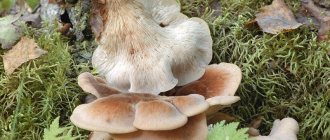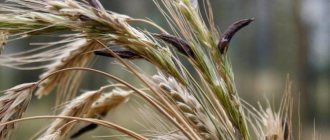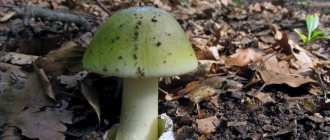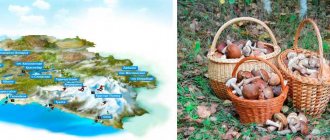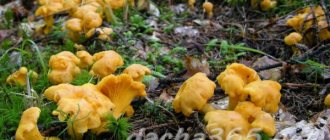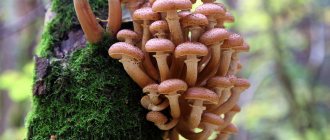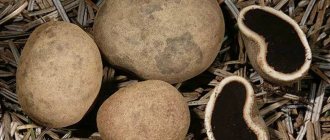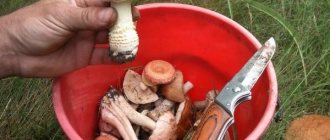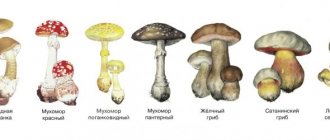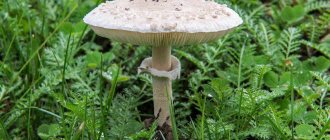One of the most common mushrooms in the middle climate zone is honey mushroom. They are edible and inedible, growing in colonies most often around stumps. This group includes representatives of five genera from three different families. In addition, mushrooms very similar to honey mushrooms, as well as poisonous species of the latter, are quite common.
Among the wide variety of mushroom counterparts, there are often poisonous species, the danger of which cannot be mitigated by soaking or heat treatment. Among them are false, sulfur-yellow, brick-red honey fungus. Distinctive features of these varieties are more intense bright coloring, surface texture, coloring, and structural differences in the stem.
Features of the view and photo
Most mushrooms that live in large colonies near stumps are popularly called honey mushrooms. This group includes species that also grow in open areas among grass. There are seasonal varieties of honey mushrooms and most of them are completely edible for humans.
The summer species is found from mid-spring to late autumn in deciduous forests of the middle zone. The size of the smooth, slightly slimy cap of adult representatives of the species can reach 6 cm. Its convex shape changes as it grows, growing in width and forming a wide tubercle in the center.
Color varies from light yellow to dark brown. The dense leg with a ring in the upper part reaches a height of 7 cm. The lower half of the leg is covered with dark scales, and on its upper part there is a ring.
Autumn honey fungus grows on stumps, roots and tree trunks. Most often, this mushroom is found in large groups in damp autumn forests from late August to the very beginning of winter at temperatures not lower than 100 C. Its distinctive external features are scaly legs and caps of brown shades with a diameter of up to 17 cm.
Being a parasite, the winter honey fungus settles on deciduous trees and dead wood. It grows in dense colonies in the cold season and can often be found even under the snow. The winter variety of the mushroom is characterized by the presence of a small light brown stem cap up to 7 cm long.
Growing
Some honey mushroom lovers have long learned to grow them themselves and not waste time walking through the forest. In order for mushrooms to grow together, it is necessary to create conditions.
- Optimal temperature (+10-15).
- High humidity (more than 70%).
- Gentle lighting, ventilation.
- Prevention of diseases and pests.
On the stumps
A minimally costly option, quite close to the natural environment. Choose the stumps of any deciduous tree, if these are summer mushrooms. The wood must be dense, without bark beetles, and have a diameter of at least 15 cm. The stump is moistened from the outside and to the very center. Watering the stump lasts up to 2 days. A rich dark color appears on the cut after absorbing moisture.
Mature caps are selected; the lower part should be dark brown. Fill them with water without chlorine and soak for 24 hours. After infusion, the caps are kneaded and the mass is ground through gauze. Water with spores is applied to the stump, and the area is covered with moss or sawdust.
The waiting period for mushrooms on stumps is up to 2 years. The fruiting period can last up to 5 years.
You can also grow honey mushrooms on a stump from mycelium. It is taken from a well-rotten stump. The mycelium is divided into pieces and placed in recesses on the stump. Cover with moss or sawdust. The stump is covered with polyethylene to retain moisture.
Expert opinion
Melnikov Vladimir Mikhailovich
Knows 1000 ways to cook, pickle and marinate any types of mushrooms
For the winter, the stump is covered with spruce branches, which are removed in early summer. Stumps with mycelium can be kept in the basement; they are covered with straw. The walls are wiped daily with a damp cloth to maintain moisture.
In banks
You can also place glass containers on windows. This method is ideal for growing honey mushrooms in winter. The side should be north to avoid direct exposure to sunlight.
For the base, use sawdust and water, removing sunflower seeds. Also, in special stores they purchase a substrate that contains optimal soil for mushrooms. The prepared mixture is poured with water for a day, squeezed out and placed in jars until half full.
The jars are sterilized in boiling water for at least an hour. The procedure is repeated for 2 days. When they cool, they are covered with a plastic lid and slits are made. The mycelium is injected with a syringe, the container is kept in a warm place. 15 days after germination of the mycelium, you can cut the first harvest. From one 3-liter jar, up to 1.5 mushrooms are collected, if all conditions have been met.
Edible and conditionally edible mushrooms similar to honey mushrooms
The ability to distinguish “good” forest products from “bad” ones is vital, since the health and life of people who eat them depend on it.
Edible flakes
This species is most often found in temperate climates. Its cap with dark scales can grow up to 20 cm in diameter, and the leg often reaches a length of 15 cm.
Young specimens are characterized by a rich reddish color. The elastic, hard pulp does not change color when damaged. Such fruits grow singly or in groups in deciduous or mixed forests from mid-summer to late autumn.
The flake is a semi-edible species and contains substances that have a beneficial effect on the human body. It is used in medicine in the treatment of gout and other joint diseases.
Other
The yellow-red row can be found from late summer to the first half of autumn on dead wood in coniferous forests. There are scales on its cap. In addition to the bright color, a characteristic external feature is the absence of a ring under the cap. This mushroom must be soaked and boiled before use.
Row yellow-red
Edible meadow mushrooms can be consumed without danger to health in almost any form. From summer to mid-autumn they are found in forest clearings, meadows, and gardens. Externally, small mushrooms with a light brown cap and a thin stem are distinguished by a pronounced mushroom aroma.
Honey fungus is found from early summer to late October in open areas, roadsides, forest clearings, and gardens. This small mushroom (6 cm high) has an excellent taste, so it is very popular among mushroom pickers.
Beneficial features
Edible honey mushrooms smell good, with a mild woody flavor. Calorie content per 100 grams - 22 kcal. The composition contains carbohydrates, fats and proteins, dietary fiber, ash, micro and macroelements. Honey mushrooms are a source of vitamins, but without many calories.
Mushrooms have a slight laxative effect and are useful for constipation of various types. In folk medicine, honey mushrooms are used to remove warts. They contain sugars and substances that prevent tumor growth.
Regular consumption of honey mushrooms is useful for E. coli and staphylococcal infections. Improves the functioning of the thyroid gland.
Poisonous and inedible doubles
Beginning mushroom pickers should study the important distinguishing characteristics of each representative from the group of poisonous counterparts in order to avoid poisoning.
Inedible flakes
Sticky scales grow on dead trees and stumps. As it grows, the shape of its cap changes from hemispherical to prostrate, convex in the center with drooping smooth edges and sparse scales. The mushroom has a light brown, beige color. Its narrowed bottom leg with yellow dense flesh has a cylindrical shape. Like most inedible mushrooms, the flesh is characterized by a bitter taste.
The destructive flake is characterized by a convex semicircular beige cap with a diameter of 6-15 cm, covered with wide white scales. The thick leg, which has a widening at the bottom, is as if dotted with light scales in the form of flakes. The whitish pulp of a cork consistency has a strong unpleasant odor and bitter taste. Most often, this mushroom grows on the trunks of deciduous trees.
False honey mushrooms
In autumn, at the height of the mushroom season, along with real honey mushrooms, you can find their doubles. The false brick-red honey fungus looks like a summer species with a smooth cap, only without a skirt and scales on the stem. The mushroom bears fruit from August to October, so it can end up in mushroom pickers’ baskets instead of autumn mushrooms. Due to their toxicity, it is better to avoid such fruits, which have a reddish tint.
False brick-red honey fungus
The whitish talker looks very similar to the meadow honey fungus. This mushroom also grows in open spaces. The flat or depressed white cap with a whitish tint becomes covered with mucus in wet weather. It is the absence of a convex center on the cap that is an important distinguishing feature. In addition, belonging to this species is indicated by more frequent yellowish plates.
The talker is whitish
Poisonous sulfur-yellow honey mushrooms
At the beginning of their life, these mushrooms resemble a bell with a ring on the stem. Mature honey mushrooms are distinguished by smooth, dry caps up to 7 cm in diameter, in the center of which there is a tubercle. Yellow, smooth, hollow legs reach a length of 10 cm. A distinctive feature is the fringe on the edge of the cap and the absence of any scales.
The sulfur-yellow species is characterized by a strong unpleasant odor. An important difference between these poisonous “gifts of the forest” and edible ones are the bright yellow plates under the cap, which in adult individuals become black in color with an olive tint. Another unique feature is the brown spot in the center of the cap.
Rules for collecting edible mushrooms
During the “silent hunt”, it is important to exercise caution and attentiveness so as not to mistakenly select poisonous mushrooms. You need to look for honey mushrooms in deciduous forests on stumps or trunks of fallen trees.
It is important to remember the following rules for collecting honey mushrooms:
- edible mushrooms grow exclusively on wood;
- there should be a pronounced ring on the stem under the cap of real mushrooms;
- there are many scales on the cap and stem;
- the bright color of the caps and the dark plates under them are signs of false mushrooms;
- poisonous species emit a distinct unpleasant odor;
- The pulp of inedible mushrooms tastes bitter.
When going to the forest, it is recommended to take with you not a bucket, but a basket for better ventilation of the crop. It is better to lay the found fruiting bodies with their caps down or sideways. Each mushroom must be carefully examined, choosing intact and young ones.
Is it possible to eat brick-red honey fungus?
Experts' opinions on the edibility of mushrooms are divided. In Germany, Italy and Canada they are considered edible. In Russia, the fruits are considered inedible, but in Chuvashia they are consumed after boiling, which removes the bitterness. It is believed that honey mushrooms contain toxins that cause stomach upset. Poisoning with red-brown honey mushrooms is accompanied by the following symptoms:
- nausea;
- vomit;
- stomach ache;
- headache;
- dizziness.
Long-term storage of brown mushroom is not recommended, because the concentration of toxic substances increases.
